Renaissance
- 格式:docx
- 大小:23.09 KB
- 文档页数:6
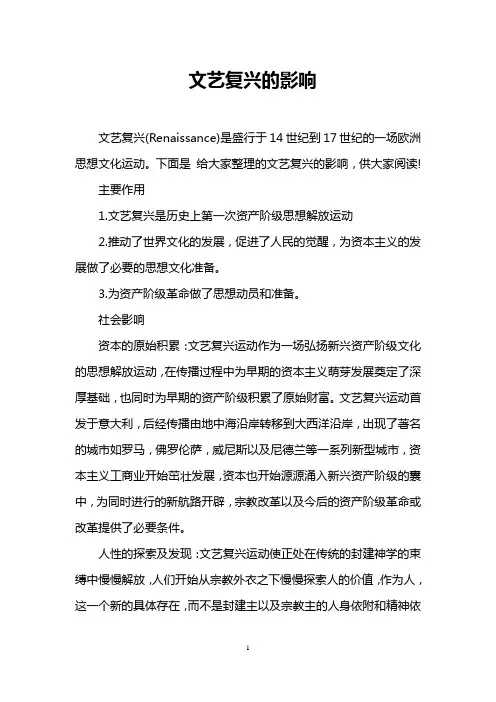
文艺复兴的影响文艺复兴(Renaissance)是盛行于14世纪到17世纪的一场欧洲思想文化运动。
下面是给大家整理的文艺复兴的影响,供大家阅读!主要作用1.文艺复兴是历史上第一次资产阶级思想解放运动2.推动了世界文化的发展,促进了人民的觉醒,为资本主义的发展做了必要的思想文化准备。
3.为资产阶级革命做了思想动员和准备。
社会影响资本的原始积累:文艺复兴运动作为一场弘扬新兴资产阶级文化的思想解放运动,在传播过程中为早期的资本主义萌芽发展奠定了深厚基础,也同时为早期的资产阶级积累了原始财富。
文艺复兴运动首发于意大利,后经传播由地中海沿岸转移到大西洋沿岸,出现了著名的城市如罗马,佛罗伦萨,威尼斯以及尼德兰等一系列新型城市,资本主义工商业开始茁壮发展,资本也开始源源涌入新兴资产阶级的囊中,为同时进行的新航路开辟,宗教改革以及今后的资产阶级革命或改革提供了必要条件。
人性的探索及发现:文艺复兴运动使正处在传统的封建神学的束缚中慢慢解放,人们开始从宗教外衣之下慢慢探索人的价值,作为人,这一个新的具体存在,而不是封建主以及宗教主的人身依附和精神依附的新时代。
文艺复兴运动充分的肯定了人的价值,重视人性,成为人们冲破中世纪的层层纱幕的有力号召。
文艺复兴运动对当时的政治,科学,经济,哲学,神学世界观都产生了极大影响。
是新兴资产阶级在意识形态领域里一场革命风暴,也被称为“出现巨人的时代"。
消极影响:文艺复兴运动在传播过程中因为过分强调人的价值,在传播后期造成个人私欲膨胀,物质享受和奢靡泛滥,有一系列的负面影响。
科学成就文学各地的作家都开始使用自己的方言而非拉丁语进行文学创作,带动了大众文学,替各种语言注入大量文学作品,包括小说、诗、散文、民谣和戏剧等。
在意大利,文艺复兴前期出现了“文学三杰”。
但丁一生写下了许多学术著作和诗歌,其中著名的是《新生》和《神曲》。
彼特拉克是人文主义的鼻祖,被誉为“人文主义之父”。
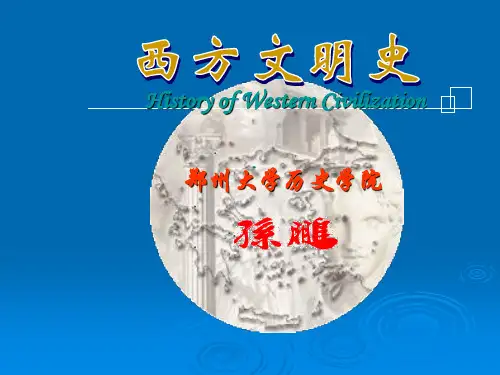
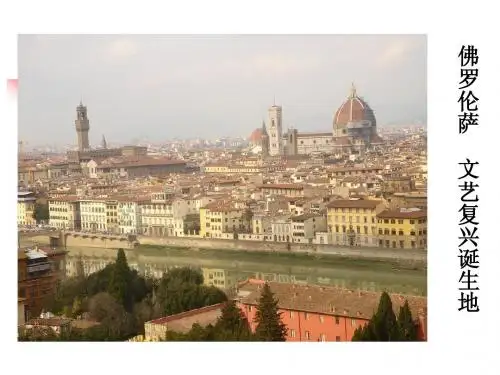
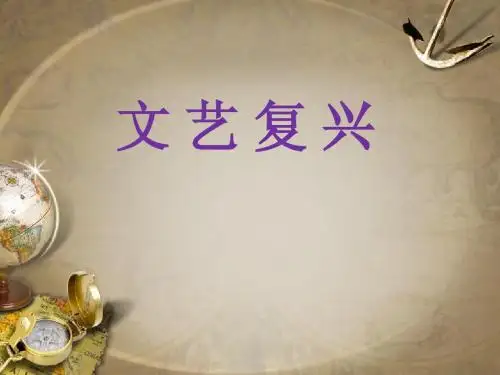
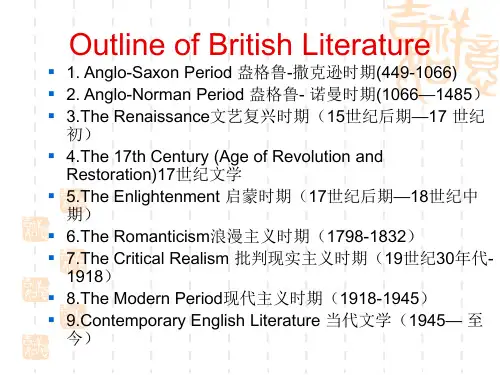
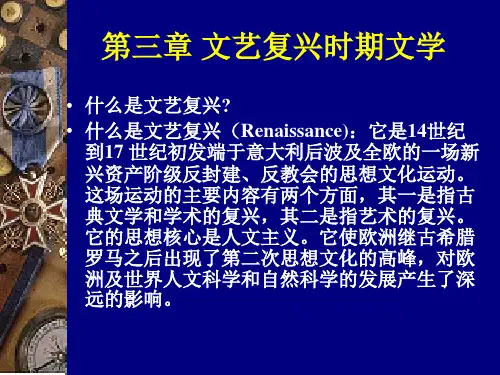
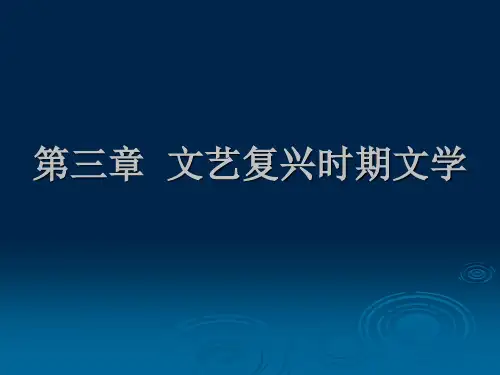
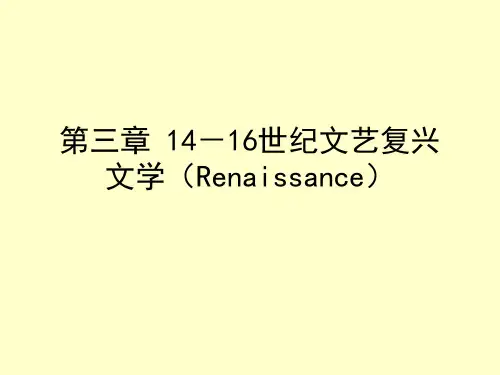
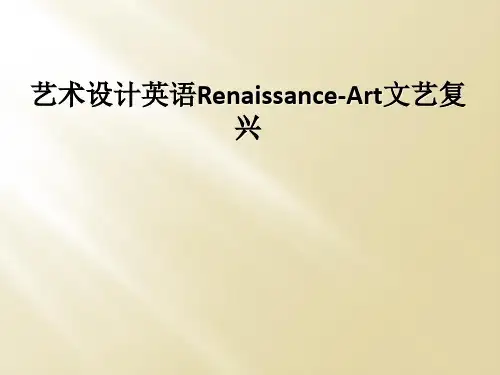
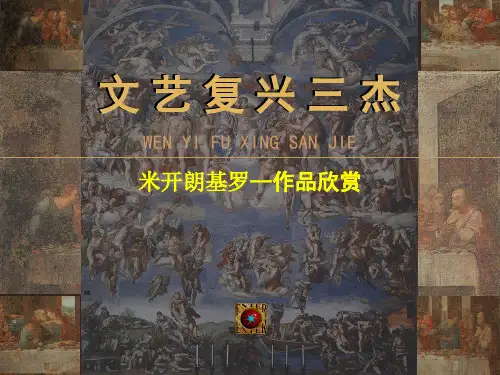
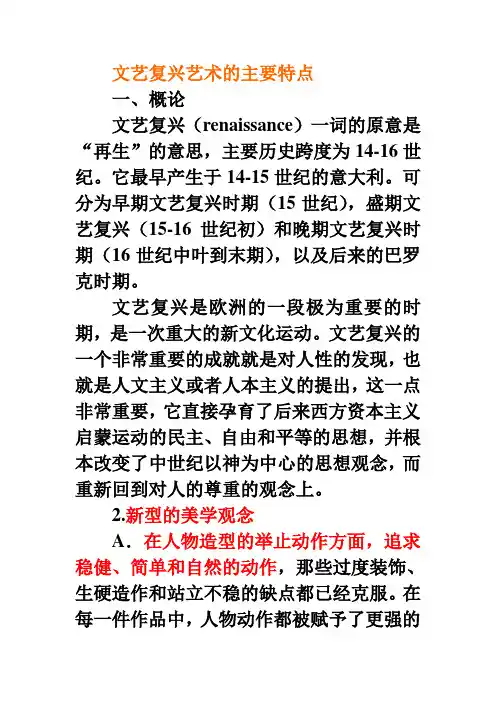
文艺复兴艺术的主要特点一、概论文艺复兴(renaissance)一词的原意是“再生”的意思,主要历史跨度为14-16世纪。
它最早产生于14-15世纪的意大利。
可分为早期文艺复兴时期(15世纪),盛期文艺复兴(15-16世纪初)和晚期文艺复兴时期(16世纪中叶到末期),以及后来的巴罗克时期。
文艺复兴是欧洲的一段极为重要的时期,是一次重大的新文化运动。
文艺复兴的一个非常重要的成就就是对人性的发现,也就是人文主义或者人本主义的提出,这一点非常重要,它直接孕育了后来西方资本主义启蒙运动的民主、自由和平等的思想,并根本改变了中世纪以神为中心的思想观念,而重新回到对人的尊重的观念上。
2.新型的美学观念A.在人物造型的举止动作方面,追求稳健、简单和自然的动作,那些过度装饰、生硬造作和站立不稳的缺点都已经克服。
在每一件作品中,人物动作都被赋予了更强的气势和活力。
新的审美观最不能容忍的是过度紧张和不自然的动作。
B.新型人体形象的出现。
早期文艺复兴的趣味更喜欢那种未充分发育的苗条轻盈的形体,青年人清瘦优雅和富于弹性的曲线,比成年女子丰腴饱满和成年男子的肌肉发达更有魅力。
但是在文艺复兴盛期,拉长形体的方法被抛弃了。
所有的肢体都被表现的更丰满、更强壮。
美再度体现在古代理想中丰满躯干的宽大臀部中,视觉上追求的是宽大而统一的的美感。
文艺复兴盛期的艺术认为关节分明的形体是富于美感的,追求人体表现的强烈结构和表现内在形式,强调形式的水平线。
因此,绘画中人体的头部变的硕大,人们欣赏结实的下巴和丰满的面颊,甚至女人的嘴巴和鼻子也不追求小巧和别致(翘鼻子),而将他们描绘的文静匀称(高直的鼻型),表现强烈的高贵特征。
人物脸颊追求对称或者匀称,追求清晰性和可辨性,追去合乎逻辑的比例关系。
这也是希腊艺术追求的目标。
C.追求艺术的重量感和节奏感,以及整体感和结构感。
比如肖像画中把头发都表现为梳得光滑服贴、有条不紊的体块。
要求有分量的衣料和潇洒飘逸的饱满形体,拒绝结构复杂的式样和琐碎的装饰,而衣裙厚重的褶子取代了有编织图案的衣料,只考虑大面积的对比关系,并要求产生一种用手牢牢握住物体的感觉,而不是用指尖轻轻触及的感觉。
发现的近古时代——文艺复兴时期的文艺理论一、“文艺复兴”概述“文艺复兴”(Renaissance):指1350-1600二百余年间的文化境况,它是西方由中世纪的神学文化过渡到近代的人文主义文化的关键时期。
“文艺复兴”一词最早是意大利艺术家瓦萨里(Giorgio Vasari,1511~1574) 1550年在其《意大利绘画、雕刻和著名建筑家列传》中提出。
托古创新的“文艺复兴”文艺复兴与人文主义人文主义(humanism)是1808年由德国教育家尼特哈麦(F. J. Niethammer)用德文humanismus 杜撰的,后来由乔治·伏格伊特在《古代经典的复活》(又名《人文主义的第一个世纪》,1859)中首用于文艺复兴。
1860年,瑞士学者布克哈特(Jacob Burckhardt,1818~1897)在《意大利文艺复兴时期的文化》一书出版,确立了文艺复兴与人文主义的同一性。
佛罗伦萨是文艺复兴的发祥地。
但丁是第一个探索自己灵魂的人,他开了意大利文艺复兴的先河。
14世纪的彼特拉克(1304-1374)和薄伽丘(1313-1375),继承了但丁的文学传统,并且进一步开拓,前者以其辉煌的诗歌创作,被称为“诗圣”,后者则创作了堪与但丁《神曲》相媲美的“人曲”——《十日谈》。
如果说但丁主要是总结了过去,那么彼特拉克则展示了未来,其作品更具人文主义的内涵,他们堪称真正意义上的近代作家,他们代表了文艺复兴的最早阶段。
学者与文献层面1453年东罗马帝国灭亡,大批学者逃往意大利。
古希腊典籍、文物出土。
“古典学术的再生”、“人文精神的复活”。
“这是一个发现的时代。
”人文主义、文艺复兴、宗教改革、地理大发现,还有这一时期刚刚复活而在下一世纪得以巨大发展的精密实验科学,构成了200多年近古时代的主要内容。
布克哈特在《意大利文艺复兴时期的文化》中说,这是一个发现的时代,即人的发现和世界的发现。
这又是一个冒险的时代,即向各个领域发动前所未有的探索。
01. Humanism(人文主义)1>Humanism is the essence of the Renaissance.2> it emphasizes the dignity of human beings and the importance of the present life. Humanists voiced their beliefs that man was the center of the universe and man did not only have the right to enjoy the beauty of the present life, but had the ability to perfect himself and to perform wonders.02. Renaissance(文艺复兴)1>The word “Renaissance”means “rebirth”, it meant the reintroduction into western Europe of the full cultural heritage of Greece and Rome.2>the essence of the Renaissance is Humanism. Attitudes and feelings which had been characteristic of the 14th and 15th centuries persisted well down into the era of Humanism and reformation.3> the real mainstream of the English Renaissance is the Elizabethan drama with William Shakespeare being the leading dramatist.03. Metaphysical poetry(玄学派诗歌)1>Metaphysical poetry is commonly used to name the work of the 17th century writers who wrote under the influence of John Donne.2>with a rebellious spirit, the Metaphysical poets tried to break away from the conventional fashion of the Elizabethan love poetry.3>the diction is simple as compared with that of the Elizabethan or the Neoclassical periods, and echoes the words and cadences of common speech.4>the imagery is drawn from actual life.04. Classicism(古典主义)Classicism refers to a movement or tendency in art, literature, or music that reflects the principles manifested in the art of ancient Greece and Rome. Classicism emphasizes the traditional and the universal, and places value on reason, clarity, balance, and order. Classicism, with its concern for reason and universal themes, is traditionally opposed to Romanticism, which is concerned with emotions and personal themes.05. Enlightenment(启蒙运动)1>Enlightenment movement was a progressive philosophical and artistic movement which flourished in France and swept through western Europe in the 18th century.2> the movement was a furtherance of the Renaissance from 14th century to the mid-17th century.3>its purpose was to enlighten the whole world with the light of modern philosophical and artistic ideas.4>it celebrated reason or rationality, equality and science. It advocated universal education.5>famous among the great enlighteners in England were those great writers like Alexander pope. Jonathan Swift. etc.06.Neoclassicism(新古典主义)1>In the field of literature, the enlightenment movement brought about a revival of interest in the old classical works.2>this tendency is known as neoclassicism. The Neoclassicists held that forms of literature were to be modeled after the classical works of the ancient Greek and Roman writers such as Homer and Virgil and those of the contemporary French ones.3> they believed that the artistic ideals should be order, logic, restrained emotion and accuracy, and that literature should be judged in terms of its service to humanity.07. The Graveyard School(墓地派诗歌)1>The Graveyard School refers to a school of poets of the 18th century whose poems are mostly devoted to a sentimental lamentation or meditation on life. Past and present ,with death and graveyard as themes.2>Thomas Gray is considered to be the leading figure of this school and his Elegy written in a country churchyard is its most representative work.08. Romanticism(浪漫主义)1>In the mid-18th century, a new literary movement called romanticism came to Europe and then to England.2>It was characterized by a strong protest against the bondage of neoclassicism, which emphasized reason, order and elegant wit. Instead, romanticism gave primary concern to passion, emotion, and natural beauty.3>In the history of literature. Romanticism is generally regarded as the thought that designates a literary and philosophical theory which tends to see the individual as the very center of all life and experience. 4> The English romantic period is an age of poetry which prevailed in England from 1798 to 1837. The major romantic poets include Wordsworth, Byron and Shelley.09. Byronic Hero(拜伦式英雄)1>Byronic hero refers to a proud, mysterious rebel figure of noble origin.2> with immense superiority in his passions and powers, this Byronic Hero would carry on his shoulders the burden of righting all the wrongs in a corrupt society. And would rise single-handedly against any kind of tyrannical rules either in government, in religion, or in moral principles with unconquerable wills and inexhaustible energies.3> Byron’s chief contribution to English literature is his creation of the “Byronic Hero”10. Critical Realism(批判现实主义)1>Critical Realism is a term applied to the realistic fiction in the late 19th and early 20th centuries.2> It means the tendency of writers and intellectuals in the period between 1875 and 1920 to apply the methods of realistic fiction to the criticism of society and the examination of social issues.3> Realist writers were all concerned about the fate of the common people and described what was faithful to reality.4> Charles Dickens is the most important critical realist.11. Aestheticism(美学主义)1>The basic theory of the Aesthetic movement--- “art for art’s sake” was set forth by a French poet, Theophile Gautier, the first Englishman who wrote about the theory of aestheticism was Walter Pater.2> aestheticism places art above life, and holds that life should imitate art, not art imitate life.3> According to the aesthetes, all artistic creation is absolutely subjective as opposed to objective. Art should be free from any influence of egoism. Only when art is for art’s sake, can it be immortal. They believed that art should be unconcerned with controversial issues, such as politics and morality, and that it should be restricted to contributing beauty in a highly polished style.4> This is one of the reactions against the materialism and commercialism of the Victorian industrial era, as well as a reaction against the Victorian convention of art for morality’s sake, or art for money’s sake.美学运动的基本原则”为艺术而艺术”最初由法国诗人西奥费尔.高缔尔提出,英国运用该美学理论的第一人是沃尔特.佩特.美学主义崇尚艺术高于生活,认为生活应模仿艺术,而不是艺术模仿生活.在美学主义看来,所有的艺术创作都是绝对主观而非客观的产物.艺术不应受任何功利的影响,只有当艺术为艺术而创作时,艺术才能成为不朽之作.他们还认为艺术不应只关注一些热点话题如政治和道德问题,艺术应着力于以华丽的风格张扬美.这是对维多利亚工业发展时期物质崇拜的一种回应,也是向艺术为道德或为金钱而服务的维多利亚传统的挑战.12.The Victorian period(维多利亚时期)1>In this period, the novel became the most widely read and the most vital and challenging expression of progressive thought. While sticking to the principle of faithful representation of the 18th century realist novel, novelists in this period carried their duty forward to criticism of the society and the defense of the mass.2> although writing from different points of view and with different techniques, they shared one thing in common, that is, they were all concerned about the fate of the common people. They were angry with the inhuman social institutions, the decaying social morality as represented by the money-worship and Utilitarianism, and the widespread misery, poverty and injustice.3>their truthful picture of people’s life and bitter and strong criticism of the society had done much in awakening the public consciousness to the social problems and in the actual improvement of the society.4> Charles Dickens is the leading figure of the Victorian period.13. Modernism(现代主义)1>Modernism is comprehensive but vague term for a movement , which begin in the late 19th century and which has had a wide influence internationally during much of the 20th century.2> modernism takes the irrational philosophy and the theory of psycho-analysis as its theoretical case.3> the term pertains to all the creative arts. Especially poetry, fiction, drama, painting, music and architecture.4> in England from early in the 20th century and during the 1920s and 1930s, in America from shortly before the first world war and on during the inter-war period, modernist tendencies were at their most active and fruitful.5>as far as literature is concerned, Modernism reveals a breaking away from established rules, traditions and conventions. fresh ways of looki ng at man’s position and function in the universe and many experiments in form and style. It is particularly concerned with language and how to use it and with writing itself.14. Stream of consciousness(意识流)(or interior monologue)In literary criticism, Stream of consciousness denotes a literary technique which seeks to describe an individual’s point of view by giving the written equivalent of the character’s thought processes. Stream of consciousness writing is strongly associated with the modernist movement. Its introduction in the literary context, transferred from psychology, is attributed to May Sinclair. Stream of consciousness writing is usually regarded as a special form of interior monologue and is characterized by associative leaps in syntax and punctuation that can make the prose difficult to follow, tracing as they do a character’s fragmentary thoughts and sensory feelings. Famous writers to employ this technique in the English language include James Joyce and William Faulkner.学术界认为意识流是一种通过直接描述人物思维过程来寻求个人视角的文学写作技巧。
Renaissance,literally “rebirth,” the period in European civilization immediately following the Middle Ages and conventionally held to have been characterized by a surge of interest in Classical learning and values. The Renaissance also witnessed the discovery and exploration of new continents, the substitution of the Copernican for the Ptolemaic system of astronomy, the decline of the feudal system and the growth of commerce, and the invention or application of such potentially powerful innovations as paper, printing, the mariner’s compass, and gunpowder. To the scholars and thinkers of the day, however, it was primarily a time of the revival of Classical learning and wisdom after a long period of cultural decline and stagnation.Origins and rise of humanismThe term Middle Ages was coined by scholars in the 15th century to designate the interval between the downfall of the Classical world of Greece and Rome and its rediscovery at the beginning of their own century, a revival in which they felt they were participating. Indeed, the notion of a long period of cultural darkness had been expressed by Petrarch even earlier. Events at the end of the Middle Ages, particularly beginning in the 12th century, set in motion a series of social, political, and intellectual transformations that culminated in the Renaissance. These included the increasing failure of the Roman Catholic Church and the Holy Roman Empire to provide a stable and unifying framework for the organization of spiritual and material life, the rise in importance of city-states and national monarchies, the development of national languages, and the breakup of the old feudal structures. While the spirit of the Renaissance ultimately took many forms, it was expressed earliest by the intellectual movement called humanism. Humanism was initiated by secular men of letters rather than by the scholar-clerics who had dominated medieval intellectual life and had developed the Scholastic philosophy. Humanism began and achieved fruition first in Italy. Its predecessors were men like Dante and Petrarch, and its chief protagonists included Gianozzo Manetti, Leonardo Bruni, MarsilioFicino, Pico della Mirandola, Lorenzo Valla, and Coluccio Salutati. The fall of Constantinople in 1453 provided humanism with a major boost, for many eastern scholars fled to Italy, bringing with them important books and manuscripts and a tradition of Greek scholarship.Humanism had several significant features. First, it took human nature in all of its various manifestations and achievements as its subject. Second, it stressed the unity and compatibility of the truth found in all philosophical and theological schools and systems, a doctrine known as syncretism. Third, it emphasized the dignity of man. In place of the medieval ideal of a life of penance as the highest and noblest form of human activity, the humanists looked to the struggle of creation and the attempt to exert mastery over nature. Finally, humanism looked forward to a rebirth of a lost human spirit and wisdom. In the course of striving to recover it, however, the humanists assisted in the consolidation of a new spiritual and intellectual outlook and in the development of a new body of knowledge. The effect of humanism was to help men break free from the mental strictures imposed by religious orthodoxy, to inspire free inquiry and criticism, and to inspire a new confidence in the possibilities of human thought and creations.From Italy the new humanist spirit and the Renaissance it engendered spread north to all parts of Europe, aided by the invention of printing, which allowed literacy and the availability of Classical texts to grow explosively. Foremost among northern humanists was Desiderius Erasmus, whose Praise of Folly(1509) epitomized the moral essence of humanism in its insistence on heartfelt goodness as opposed to formalistic piety. The intellectual stimulation provided by humanists helped spark the Reformation, from which, however, many humanists, including Erasmus, recoiled. By the end of the 16th century the battle of Reformation and Counter-Reformation had commanded much of Europe’s energy and attention, while the intellectual life was poised on the brink of the Enlightenment.In Italy the Renaissance proper was preceded by an important “proto-renaissance” in the late 13th and early 14th centuries, which drew inspiration from Franciscan radicalism. St. Francis had rejected the formal Scholasticism of the prevailing Christian theology and gone out among the poor praising the beauties and spiritual value of nature. His example inspired Italian artists and poets to take pleasure in the world around them. The work of the most famous artist of the proto-renaissance period, Giotto(1266/67 or 1276–1337), reveals a new pictorial style that depends on clear, simple structure and great psychological penetration rather than on theflat, linear decorativeness and hierarchical compositions of his predecessors and contemporaries, such as the Florentine painter Cimabue and the Siennese painters Duccio and Simone Martini. The great poet Dante lived at about the same time as Giotto, and his poetry shows a similar concern with inward experience and the subtle shades and variations of human nature. Although his Divine Comedy belongs to the Middle Ages in its plan and ideas, its subjective spirit and power of expression look forward to the Renaissance. Petrarch and Boccaccio also belong to this proto-renaissance period, both through their extensive studies of Latin literature and through their writings in the vernacular. Unfortunately, the terrible plague of 1348 and subsequent civil wars submerged both the revival of humanistic studies and the growing interest in individualism and naturalism revealed in the works of Giotto and Dante. The spirit of the Renaissance did not surface again until the 15th century. In 1401 a competition was held at Florence to award the commission for bronze doors to be placed on the baptistery of San Giovanni. Defeated by the goldsmith and painter Lorenzo Ghiberti, Filippo Brunelleschi and Donatello left for Rome, where they immersed themselves in the study of ancient architecture and sculpture. When they returned to Florence and began to put their knowledge into practice, the rationalized art of the ancient world was reborn. The founder of Renaissance painting was Masaccio (1401–28). The intellectuality of his conceptions, the monumentality of his compositions, and the high degree of naturalism in his works mark Masaccio as a pivotal figure in Renaissance painting. The succeeding generation of artists—Piero della Francesca, Pollaiuolo, and Verrochio—pressed forward with researches into linear and aerial perspective and anatomy, developing a style of scientific naturalism.The situation in Florence was uniquely favourable to the arts. The civic pride of Florentines found expression in statues of the patron saints commissioned from Ghiberti and Donatello for niches in the grain-market guildhall known as Or San Michele, and in the largest dome built since antiquity, placed by Brunelleschi on the Florence cathedral. The cost of construction and decoration of palaces, churches, and monasteries was underwritten by wealthy merchant families, chief among whom were the Medici family.The Medici traded in all of the major cities in Europe, and one of the most famous masterpieces of Northern Renaissance art, The Portinari Altarpiece,by Hugo van der Goes(c.1476; Uffizi, Florence), was commissioned by their agent, Tommaso Portinari. Instead of being painted with the customary tempera of the period, the work is painted with translucent oil glazes that produce brilliant jewel-like colour and a glossysurface. Early Northern Renaissance painters were more concerned with the detailed reproduction of objects and their symbolic meaning than with the study of scientific perspective and anatomy even after these achievements became widely known. On the other hand, central Italian painters began to adopt the oil medium soon after The Portinari Altarpiece was brought to Florence in 1476.Artistic developments and the emergence of FlorenceIt was in art that the spirit of the Renaissance achieved its sharpest formulation. Art came to be seen as a branch of knowledge, valuable in its own right and capable of providing man with images of God and his creations as well as with insights into man’s position in the universe. In the hands of men like Leonardo da Vinci it was even a science, a means for exploring nature and a record of discoveries. Art was to be based on the observation of the visible world and practiced according to mathematical principles of balance, harmony, and perspective, which were developed at this time. In the works of painters such as Masaccio, the brothers Lorenzetti, Fra Angelico, Botticelli, Perugino, Piero della Francesca, Raphael, and Titian; sculptors such as Pisano, Donatello, Verrocchio, Ghiberti, and Michelangelo; and architects such as Alberti, Brunelleschi, Palladio, Michelozzo, and Filarete, the dignity of man found expression in the arts.The High RenaissanceHigh Renaissance art, which flourished for about 35 years, from the early 1490s to 1527, when Rome was sacked by imperial troops, revolved around three towering figures: Leonardo da Vinci(1452–1519), Michelangelo(1475–1564), and Raphael(1483–1520). Each of the three embodied an important aspect of the period: Leonardo was the ultimate Renaissance man, a solitary genius to whom no branch of study was foreign; Michelangelo emanated creative power, conceiving vast projects that drew for inspiration on the human body as the ultimate vehicle for emotional expression; Raphael created works that perfectly expressed the Classical spirit—harmonious, beautiful, and serene.Although Leonardo was recognized in his own time as a great artist, his restless researches into anatomy, the nature of flight, and the structure of plant and animallife left him little time to paint. His fame rests on a few completed works; among them are the Mona Lisa(1503–05; Louvre), The Virgin of the Rocks(c.1485; Louvre), and the sadly deteriorated fresco The Last Supper(1495–98; Santa Maria delle Grazie, Milan).Michelangelo’s early sculpture, such as the Pietà(1499; St. Peter’s, Vatican City) and the David (1501–04; Accademia, Florence), reveals a breathtaking technical ability in concert with a disposition to bend rules of anatomy and proportion in the service of greater expressive power. Although Michelangelo thought of himself first as a sculptor, his best-known work is the giant ceiling fresco of the Sistine Chapel in the Vatican. It was completed in four years, from 1508 to 1512, and presents an incredibly complex but philosophically unified composition that fuses traditional Christian theology with Neoplatonic thought.Raphael’s greatest work, The School of Athens(1508–11), was painted in the Vatican at the same time that Michelangelo was working on the Sistine Chapel. In this large fresco Raphael brought together representatives of the Aristotelian and Platonic schools of thought. Instead of the densely packed, turbulent surface of Michelangelo’s masterpiece, Raphael placed his groups of calmly conversing philosophers and artists in a vast court with vaults receding into the distance. Raphael was initially influenced by Leonardo, and he incorporated the pyramidal composition and beautifully modelled faces of The Virgin of the Rocks into many of his own paintings of the Madonna. He differed from Leonardo, however, in his prodigious output, his even temperament, and his preference for Classical harmony and clarity.The creator of High Renaissance architecture was Donato Bramante(1444–1514), who came to Rome in 1499, when he was 55. His first Roman masterpiece, the Tempietto (1502) at San Pietro in Montorio, is a centralized dome structure that recalls Classical temple architecture. Pope Julius II (reigned 1503–13) chose Bramante to be papal architect, and together they devised a plan to replace the 4th-century Old St. Peter’s with a new church of gigantic dimensions. The project was not completed, however, until long after Bramante’s death.Humanistic studies continued under the powerful popes of the High Renaissance, Julius II and Leo X, as did the development of polyphonic music. The Sistine Choir, which performed at services when the pope officiated, drew musicians and singers from all of Italy and northern Europe. Among the most famous composers who became members were Josquin des Prez (1445–1521) and Palestrina (1525–84).Competition from MannerismThe Renaissance as a unified historical period ended with the fall of Rome in 1527. The strains between Christian faith and Classical humanism led to Mannerism in the latter part of the 16th century. Great works of art animated by the Renaissance spirit, however, continued to be made in northern Italy and in northern Europe. Seemingly unaffected by the Mannerist crisis, northern Italian painters such as Correggio(1494–1534) and Titian(1488/90–1576) continued to celebrate both Venus and the Virgin Mary without apparent conflict. The oil medium, introduced to northern Italy by Antonello da Messina and quickly adopted by Venetian painters who could not use fresco because of the damp climate, seemed particularly adapted to the sanguine, pleasure-loving culture of Venice. A succession of brilliant painters—Giovanni Bellini, Giorgione, Titian, Tintoretto, and Veronese—developed the lyrical Venetian painting style that combined pagan subject matter, sensuous handling of colour and paint surface, and a love of extravagant settings. Closer in spirit to the more intellectual Florentines of the Quattrocento was the German painter Albrecht Dürer (1471–1528), who experimented with optics, studied nature assiduously, and disseminated his powerful synthesis of Renaissance and Northern Gothic styles through the Western world by means of his engravings and woodcuts.。